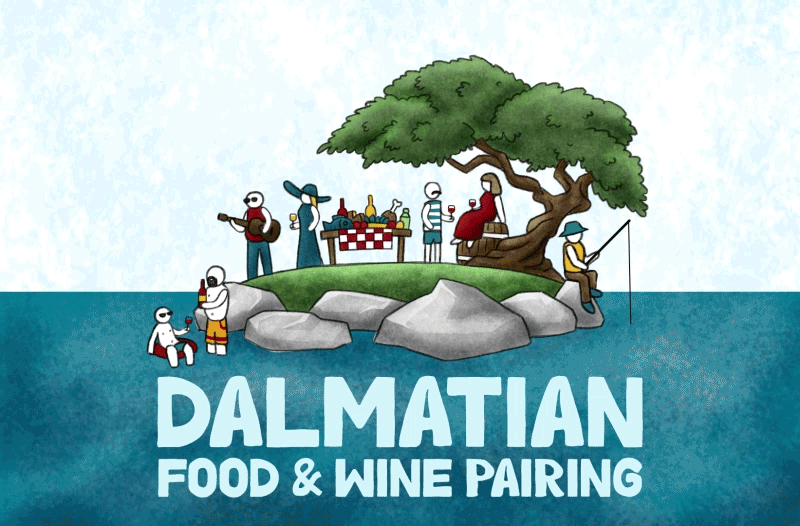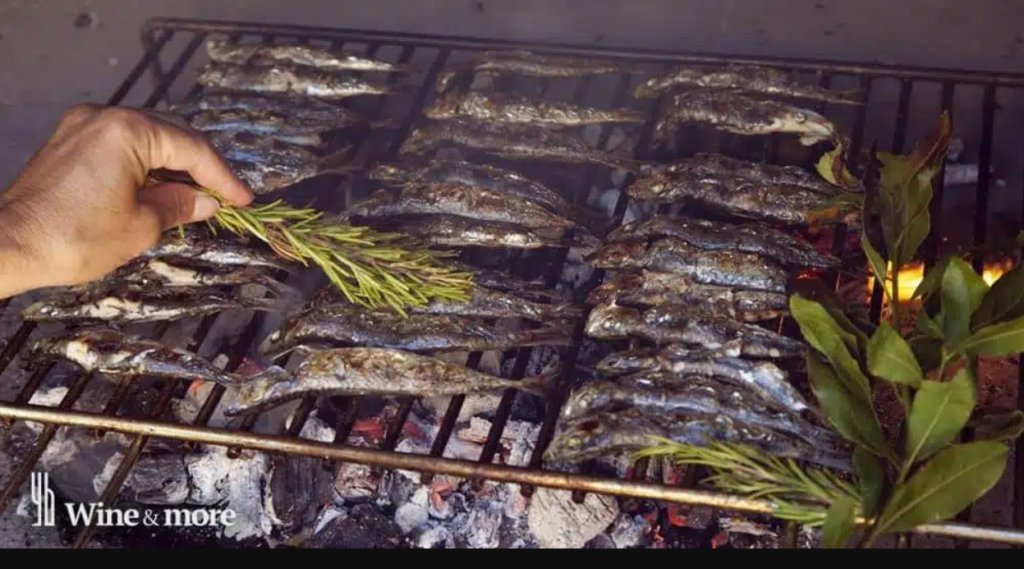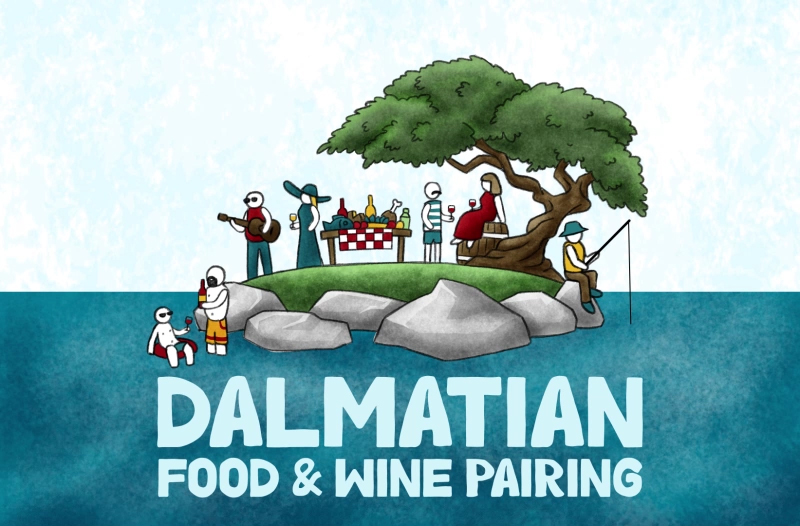May 07, 2024 – Regarding Dalmatian food and wine pairing, it’s hard to know where to begin. With a plethora of indigenous grape varieties and a diverse cuisine, it may seem overwhelming. But don’t worry! Come along with us and our friends at Wine&more as we discover the art of matching Dalmatian dishes with Dalmatian wines.

Dalmatian cuisine: overview
Exploring the culinary delights of Dalmatia in Croatia is a dream for food lovers. Every recipe and dish here reflects the deep-rooted love for food ingrained in the Dalmatian lifestyle and culture.
Dalmatian cuisine derives its unique flavor from local ingredients and traditional cooking methods passed down through generations. It’s this deep appreciation for delicious food that makes Dalmatian cuisine stand out.
Abundant in seafood and featuring authentic meat dishes, Dalmatian cuisine combines various Mediterranean flavors. The coastal ambiance and timeless traditions shape the essence of its culinary delights.
Shaped by centuries of history, Dalmatian cuisine is a captivating blend of cultural influences. From ancient Roman and Greek flavors to Italian touches, it tells a unique story of merging traditions.
Dalmatian wines complement the region’s cuisine beautifully with a variety of local, indigenous grape varieties.
Whether it’s a refreshing white wine with seafood or full-bodied reds with hearty stews, each sip and bite is a taste of Dalmatia’s rich history and traditions.
HOW TO PAIR wine with Dalmatian cuisine?
Croatia, particularly its Dalmatian coast, beckons wine lovers with its exquisite and diverse wine offerings. Pairing these wines with Dalmatian cuisine means understanding how each wine’s distinct traits complement the flavors and textures of local dishes. It’s all about finding the right balance of acidity and tannins to enhance the richness of authentic Dalmatian delicacies.
Whether you’re savoring iconic dishes like octopus cooked under a bell (peka) or indulging in squid ink risotto, steamed mussels, or fish stew, there’s always a local wine that perfectly complements the meal.
Consider the main ingredient and how it’s prepared when choosing wine pairings. For instance, light white wines like Kujundžuša or Bogdanuša complement boiled or steamed white fish, while Dalmatian whites like Maraština or Vugava contrast well with seafood-rich dishes like brodet and scampi na buzaru.
For grilled dishes, try Pošip or Debit, and for baked or roasted foods, opt for aged Pošip or macerated Maraština. Remember, the texture of the dish guides your wine choice, so adjust accordingly for the best pairing.
To make a perfect match, it’s crucial to balance the acidity in your dish with the tannins in your wine. If your food has bright acidity, go for a wine with softer tannins to harmonize the flavors.
Conversely, if your dish is less acidic but has richer flavors, a wine with higher tannin levels can complement it nicely. Achieving this balance enhances the overall dining experience.
Understanding how to balance acidity and tannins opens up a world of options for creating delicious pairings. It ensures that neither element dominates, letting both the food and wine shine together.
7 MUST-TRY Dalmatian FOOD AND WINE PAIRINGS
Explore our pick of the top five authentic Dalmatian dishes for a genuine food and wine pairing experience.
Janjetina ispod peke (slow-cooked lamb under the bell)
Slow-cooked lamb under the bell, known as Janjetina ispod peke, showcases Dalmatia’s expertise in meat dishes, despite its coastal fame for seafood.
Peka, a bell-shaped cast iron lid, is the star of this traditional cooking method, used for various dishes including lamb, veal, or octopus. The dish simmers slowly under the peka lid over an open fire, resulting in tender, flavorful meat infused with aromatic herbs like rosemary and sage.
Janjetina ispod peke, featuring lamb slow-cooked to perfection, is a regional favorite. Paired with wines like Vislander Plavac Mali Tihobraće, known for its strong structure and expressed tannins will elevate the dining experience with its savory flavors and tender texture.
Pašticada (braised beef stew)
Now, let’s talk about another classic Dalmatian delight – Pašticada. This braised beef dish is bursting with rich flavors and is often served with homemade pasta or gnocchi, making it a beloved staple in Dalmatian cuisine.
To prepare pašticada, beef is marinated in vinegar and spices for a couple of days, then slow-cooked in red wine or Prošek along with bacon, tomatoes, dried prunes or figs, and root vegetables. Traditionally served at weddings and special gatherings, this dish can be topped with grated cheese for an extra flavor boost.
Pašticada pairs perfectly with Plavac Mali Milna from Vislander Winery, a robust wine with a strong structure and bold tannins.
Brujet, brudet or brodet (fish stew)
Let’s move on from the delicious slow-cooked meats and explore another iconic dish of Dalmatian cuisine – Brudet. Fish brudet is a beloved traditional dish enjoyed across Dalmatia, Kvarner, and Istria regions of Croatia. Whether you call it brujet, brudet, or brodet, one thing’s for sure – it’s delicious!
For fish brudet, you can use various fresh fish, shellfish, and crustaceans like monkfish, grouper, scorpionfish, and hake, along with shrimp and other shellfish. The key is to have a variety of fish for maximum flavor. But don’t worry if you can’t find them all – you can even make it with anchovies!
These ingredients are simmered in a savory tomato-based sauce infused with Mediterranean herbs, onions, garlic, and a dash of vinegar for a delightful balance of flavors. Sometimes, bay leaves and chili peppers are added for extra taste.
Brudet is traditionally served with polenta, and it pairs perfectly with Vislander Bugava Antique. This wine is creamy yet vibrant, with a full-bodied, structured taste that layers beautifully on the palate, enhancing the flavors of the dish.
Scampi buzara (Shrimp) in red tomato sauce
Scampi Buzara in red tomato sauce is a tasty dish where scampi are cooked in a rich tomato sauce. Scampi, or prawns, are sautéed with garlic, onions, and tomatoes to create a savory base. Herbs like parsley, basil, and red pepper flakes are added for extra flavor.
The sauce simmers until the scampi are cooked through and soaked in the tomato sauce’s vibrant flavors. Served hot and garnished with fresh herbs, it’s a delightful seafood dish typical of coastal Croatia. This cooking style is common in Dalmatia and Istria, where similar seafood dishes are enjoyed with crusty bread for dipping.
While scampi are the usual choice, other seafood like mussels, clams, or small fish can also be cooked this way. Choosing the right wine for tomato-based dishes like this can be tricky. You’ll want a wine that balances the sauce’s acidity while complementing its sweetness and depth.
A fresh, lively red like Darnekuša works well, with its low tannins and high acidity. Plavina is another good option, with lower alcohol and softer tannins but higher acidity. For scampi buzara, a crisp rosé like Vislander Rose is recommended. Its lively acidity adds a playful balance to the sauce’s concentrated flavors, making it a perfect match for this dish.
Dalmatian mussels buzara (Dagnje na buzaru)
Buzara, a local term for “stew,” is a beloved dish in Croatian coastal cuisine, often made with shellfish or crabs. Dagnje na buzaru, or Dalmatian mussels buzara, is a classic coastal dish made with mussels as the star ingredient.
The mussels are cleaned and gently heated in a pot until they open up. Meanwhile, a mix of olive oil, garlic, parsley, and pepper is sautéed in another pan. This flavorful mix is then combined with the mussels, along with lemon slices and a splash of white wine, and simmered briefly. Some breadcrumbs may be added to thicken the sauce before serving, with plenty of bread on the side for dipping.
Mussels go well with richer white wines like Vislander Bugava Premier. Another popular variation involves cooking fresh mussels in a savory red tomato wine sauce, with garlic and parsley. When served with a red sauce, similar wine pairing principles apply as with scampi dishes.
Ston oysters and mussels
Oysters and mussels from Ston and Mali Ston are highly prized by both locals and tourists alike. The eastern part of the Pelješac Peninsula, particularly the Ston area, is renowned for cultivating top-quality European flat oysters and mussels. These shellfish benefit from the region’s pristine seawater and favorable marine conditions, resulting in exceptional flavor and texture.
Oyster farming has been a tradition in Dalmatia since ancient Roman times, with locals preserving the European Oyster, a species endangered elsewhere. Enjoyed best when served raw and tender, these delicacies are typically presented on ice with a squeeze of fresh lemon juice.
Pairing these delectable treats with chilled, youthful wines like Kujundžuša, Debit, or lively sparkling wines such as Vislander Komiška Bonda, a blend of Kuč and Vugava grapes, elevates the dining experience to new heights.
Riba na gradele (grilled fish)

Grilled fish, or riba na gradele, is a beloved tradition along the Dalmatian coast. The whole fish, including the head, is grilled over an open fire, either at home or in restaurants. Before grilling, the fish is dried to remove excess moisture and then placed on the preheated grill grates, called gradela, usually fueled by wood or charcoal. Throughout the cooking process, the fish is basted with rosemary-infused olive oil for added flavor.
Typically served with blitva (swiss chard), boiled potatoes, and a sauce made of olive oil, parsley, and garlic, grilled fish is a classic Dalmatian dish.
Pairing options depend on the fish’s flavor profile. For grilled white fish with a stronger taste, fresh and lively wines with pronounced minerality like Malvasia, lighter Graševina, and Vislander Vugava are excellent choices. If the fish is oily and heavily seasoned, opt for aged Pošip or macerated Malvasia. For bluefish or fish with intense grilled flavors, fuller and stronger white wines like Debit, macerated Maraština, Pošip, aged Chardonnay, and Malvasia are recommended.
CONCLUSION
In summary, Dalmatia is a paradise for both wine and food lovers. Its unique flavors and culinary traditions, deeply rooted in history, are gaining popularity among more and more people.
For those who value authenticity, tradition, and locally sourced ingredients, Dalmatia offers an abundance of culinary delights. One of the best ways to experience the true essence of Croatian cuisine and wine pairing is by dining at the cozy taverns known as “konoba” scattered along the coast.
These charming establishments often serve the hearty dishes we’ve discussed in this guide. With this overview of pairing Dalmatian food and wine, we hope you’re eager to embark on a delightful culinary adventure through the wonders of Dalmatia.
NOTE: Find more authentic Dalmatian food and wine pairing recommendations and recipes in the original article written by wineandmore.com












